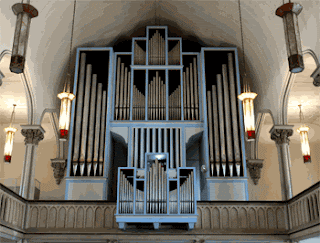Florence Mustric. Symphonies Spectacular and Sublime.
What do Trinity Lutheran in Cleveland, Marcel Dupré and Rudolf von Beckerath have in common? Quite a lot if Florence Mustric’s CD of Dupré’s Three Preludes and Fugues, published as his Opus 7, recorded on the Beckerath organ at Trinity Lutheran is any measure by which to make a judgement.
Mustric writes that she sees the Opus 7 as “a virtual symphony.” I’m not sure I agree with her entirely. I have come to regard the Opus 7 as perhaps a set of three miniature organ symphonies. For those of you who find yourself asking ‘how can anyone possibly write a symphony for one instrument?’, organ symphonies technically aren’t symphonies at all – they are more like suites or sonatas that make use of the symphonic colors available on the organs of late 19th century France.
While I could go on at length about the relationship between the music of composers like Dupré and his teacher and predecessor at Saint Sulpice in Paris, Charles-Marie Widor and the organs they played, I will simply say that it is a fascinating relationship out of which I have spun more than the occasional research paper.
Rudolf von Beckerath’s work is generally associated with the music of German Baroque composers like Bach more closely than with French Romantic music. So it naturally comes as something of a surprise to find someone performing such music on an organ, much less to find a recording of French organ music on a Beckerath. However, the Dupré and Franck are quite effective on the instrument at Trinity Lutheran.
Mustric’s tempi for the entirety of Dupré’s Opus 7 are slower than those taken by most other performers I’ve had the opportunity to listen to, but too often French Romantic organ works are rushed, losing clarity and sinking into forgettable morass. Her playing in the B-major is crisp, clear and hauntingly beautiful. There are moments, especially in the prelude where I was clearly reminded that Dupré was a student of both Widor and Vierne.
Following the B-major is the Prelude and Fugue in F-minor, where the flutes are really given an opportunity to shine. The themes in the second prelude and fugue are even more lovely and haunting than the B-Major. In a show of compositional genius (or perhaps just cleverness) the fugue theme opens with what sounds like one of the accompaniment figures from the prelude just previous.
The G-minor prelude is a dizzying flight around the room on beautiful flutes for the hands with the melody in the feet (how very organistic!). Once again the playing is clean and very crisp, with speed that other players might take traded for clarity of thought and playing. In the G-mionr fugue, Mustric once again demonstrates the full organ, and shows the versatility of the Beckerath.
Mustric follows the Dupré Op. 7 with three Chorales by César Franck, also a leading French organist of his day. Like the Dupré Preludes and Fugues, these each feel like organ symphonies in miniature. They were each well executed, cleanly played, and wonderfully crisp. The only blemish on an otherwise stunning recording is that after some time, I find myself wishing for some new colors from the Beckerath. This is not Mustric’s fault, nor the fault of Herr Beckerath; it is a slight mismatch between instrument and repertoire. That Mustric was able to convincingly pull off this recording of French Romantic music on an instrument that was designed with an eye to Bach and Baroque counterpoint is a testament to her abilities as an organist and to her great familiarity with the instrument at hand.
Personnel: Florence Mustric (organ).
Tracks: Marcel Dupré: Opus 7: Preludes and Fugues: in B major; in F minor; in G minor; César Franck: Three Chorals: Choral in E major; Choral in B minor; Choral in A minor.
Don Daley



No comments:
Post a Comment